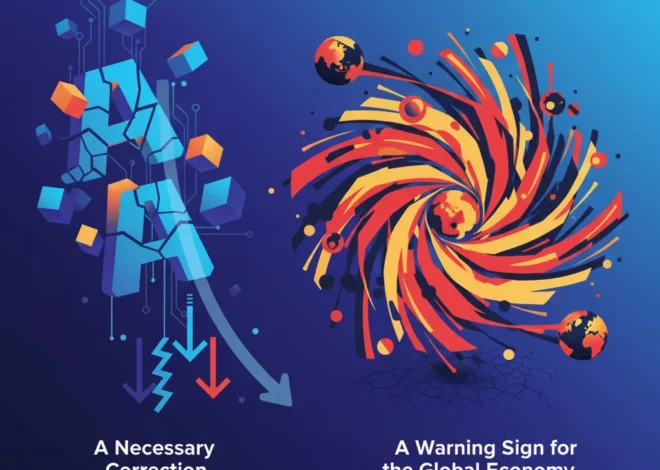
Blinded by the Light: What a Simple Headlight Review Reveals About Market Risk and Investment Opportunity
It’s a scenario familiar to anyone who drives at night: a vehicle approaches from the opposite direction, its headlights searing your retinas with the intensity of a small star. You squint, your vision blurs, and for a few dangerous seconds, you are effectively flying blind. This common frustration has now escalated into a national safety concern, prompting the UK government to launch a formal review into vehicle lighting regulations. According to a report from the BBC, the Department for Transport is responding to a wave of complaints from drivers who feel modern headlights are dangerously bright.
On the surface, this appears to be a simple issue of automotive design and public safety. However, for astute investors, finance professionals, and business leaders, this development is far more than a headline—it’s a potent market signal. It serves as a compelling case study in the complex, often turbulent intersection of technological innovation, consumer backlash, regulatory risk, and economic consequence. Just as in the fast-paced worlds of fintech and disruptive technology, the automotive sector is demonstrating how progress, if unchecked, can create negative externalities that ripple through the economy, impacting everything from supply chains to stock market valuations.
The Technological Arms Race on Our Roads
To understand the financial implications, we must first appreciate the technological shift that led us here. For decades, the humble halogen bulb dominated automotive lighting. It was cheap, reliable, and universally understood. But in the relentless pursuit of efficiency, performance, and design aesthetics, automakers have engaged in a lighting arms race. This evolution has progressed through several distinct phases, each with its own economic footprint.
The introduction of High-Intensity Discharge (HID) lamps in the 1990s was the first major leap, offering a brighter, whiter light. Then came the LED revolution. Light-Emitting Diodes offered unprecedented design flexibility, a longer lifespan, and significant energy savings—a key selling point in an era of tightening emissions standards. Today, we are entering the age of adaptive matrix LED and even laser headlights, sophisticated systems that can carve out dark spots around other vehicles, theoretically reducing glare while maximizing illumination.
This rapid innovation has fueled a multi-billion dollar sub-sector of the automotive industry. Companies specializing in lighting technology have become critical players in the automotive supply chain. However, this progress has come at a cost, both literal and figurative. The R&D expenditure is immense, and the per-unit cost of these advanced systems is orders of magnitude higher than their halogen predecessors. This investment is justified by automakers as a premium feature, a marketable differentiator that adds to a vehicle’s sticker price and perceived value.
Here is a simplified breakdown of the evolution of headlight technology and its market characteristics:
| Technology | Approx. Introduction | Key Advantages | Key Disadvantages | Market Position |
|---|---|---|---|---|
| Halogen | 1960s | Low cost, simple to replace | Low efficiency, shorter lifespan, yellowish light | Economy/Base models |
| High-Intensity Discharge (HID/Xenon) | 1990s | Brighter & whiter than halogen, more efficient | Higher cost, complex, warm-up time | Mid-range/Older premium models |
| Light-Emitting Diode (LED) | 2000s | Highly efficient, long life, design flexibility, instant on | High initial cost, glare potential if poorly designed | Standard on most new vehicles |
| Matrix/Adaptive LED & Laser | 2010s | Precision light control, anti-glare features, maximum illumination | Extremely high cost, regulatory complexity, repair difficulty | High-end luxury & premium models |
The widespread adoption of LED technology, in particular, is the primary source of the glare issue. Their intensity, coupled with the higher ride height of popular SUVs, often directs this powerful light directly into the eyes of other drivers. This unintended consequence is a classic example of a negative externality—a cost imposed on a third party who is not directly involved in the economic transaction.
Gove's High-Stakes Gamble: Can a 1.5 Million Home Target Reshape the UK Economy?
A Familiar Pattern: Parallels with Financial Technology and Blockchain
For those in the world of finance and financial technology, this pattern of innovation outpacing regulation is strikingly familiar. Consider the rise of decentralized finance (DeFi) on the blockchain. It promised to democratize banking and create a more efficient financial system. However, its rapid, largely unregulated growth also led to unforeseen risks, including smart contract exploits, market manipulation, and significant investor losses. Regulators are now playing catch-up, attempting to impose order on a system that was designed to resist it.
The headlight dilemma is a physical-world analogue. The technology to create incredibly bright, efficient lights (the “innovation”) raced ahead, driven by market demand for safety and style. The regulations and real-world testing (the “governance”), however, failed to keep pace with the social consequences of that innovation. The current government review is the market’s delayed immune response, an attempt to correct a course that has prioritized technological capability over collective well-being.
Mapping the Economic Ripple Effect
A government-mandated change to headlight standards, however small, will not occur in a vacuum. The ripples will spread across a vast economic pond, creating both headwinds and tailwinds for various sectors.
1. Automotive Manufacturers and Suppliers: The most immediate impact will be felt here. Companies that have invested heavily in the current generation of high-intensity LED systems may face significant costs. This could include:
- R&D Write-Downs: Research and development costs for technologies deemed non-compliant could be written down, affecting quarterly earnings.
- Re-tooling Production Lines: Adjusting manufacturing processes to accommodate new standards requires capital expenditure.
- Recall and Retrofit Costs: In a worst-case scenario, a widespread recall could cost billions. A study by Stout Risius Ross found that the average cost of a recall for an automotive OEM is $500 per vehicle. Multiplying that across millions of cars reveals the scale of the potential financial risk.
2. The Aftermarket and Repair Industry: New regulations could create a boom for the aftermarket sector. If new, “glare-friendly” technology is mandated, companies that can design and sell compliant replacement units for existing vehicles stand to profit. This creates an interesting opportunity for investors looking at smaller, more agile players in the automotive parts space.
3. The Insurance Industry: The financial logic here is straightforward. The Royal Automobile Club (RAC) found that a staggering 85% of drivers believe the headlight glare problem is worsening. If new regulations lead to a measurable decrease in nighttime accidents, insurance companies could see a reduction in claims. This would improve their loss ratios and boost profitability, potentially making insurance stocks a safer, albeit indirect, play on this regulatory shift.
4. Technology and Semiconductor Companies: The solution to the glare problem may itself be a technological one. More sophisticated adaptive driving beam (ADB) systems, which use cameras and processors to shape the light beam in real-time, are the likely answer. This increases the demand for the underlying components: cameras, sensors, and, most importantly, automotive-grade microcontrollers and processors. This trend reinforces the broader investment thesis of “more silicon in every car” and benefits semiconductor firms that have a strong foothold in the automotive sector.
Beyond the Balance Sheet: What a Local Food Pantry Reveals About the Future of Finance and Investing
A Blueprint for Strategic Investing and Leadership
So, how can investors and business leaders use this information to their advantage? It’s about moving beyond reactive analysis and developing a proactive framework for identifying similar patterns across the entire economy.
For Investors:
- Scrutinize the Supply Chain: Don’t just look at the major car brands. Investigate their key lighting suppliers (e.g., Hella, Koito, Valeo, Osram). Which of them are already leading in adaptive, anti-glare technology? These companies are better positioned to weather, and even profit from, regulatory changes.
- Look for “Solution” Stocks: Identify companies that provide the enabling technologies for the solution. This includes sensor manufacturers, software developers specializing in machine vision, and semiconductor companies.
- Factor in Regulatory Risk: When evaluating any company heavily reliant on a single technology or product class, regulatory risk should be a key variable in your valuation model. The headlight issue is a reminder that public opinion can quickly crystallize into profit-eroding regulation.
For Business Leaders:
- Embrace Proactive Governance: Don’t wait for the regulator. The companies that will win are those that are already studying the second-order effects of their innovations. A robust product development cycle should include not just technical performance but also a “social impact assessment.”
- Build for Adaptability: In a world of rapid technological and regulatory change, rigid, monolithic systems are a liability. Building modular platforms—whether in software, financial technology, or automotive hardware—allows a company to adapt to new standards without a complete overhaul.
- Turn Compliance into a Competitive Advantage: Instead of viewing new regulations as a burdensome cost, frame them as a marketing opportunity. Being the first to market with a “certified glare-free” headlight system could become a powerful selling point, building brand trust and capturing market share. A government press release on the topic highlights that international standards are being reviewed, indicating this is a global trend to get ahead of.
Beyond the Slice: A Financial Autopsy of Pizza Hut's UK Restructuring
Conclusion: Seeing the Bigger Picture
The controversy over dazzling headlights is more than just a passing annoyance. It is a powerful metaphor for the challenges of our modern economy. It highlights the constant tension between the drive for innovation and the need for social responsibility. It proves that even the most well-intentioned technological advancements can have costly, unforeseen consequences.
For those of us in the worlds of finance, investing, and business, the key takeaway is to widen our aperture. The most significant risks and the most lucrative opportunities often lie hidden in plain sight, disguised as everyday problems. By learning to connect these seemingly minor social frictions to their underlying technological drivers and potential regulatory outcomes, we can move from being blinded by the glare of the present to clearly seeing the road ahead.


